Elche is a city in central Spain with almost 200,000 inhabitants. Elche is about 10 km from the sea and only 15 km from the metropolis of Alicante. In Valancian (this language is spoken by many people in this region) the city is called Elx. Elche is the capital of palm trees and city parks. A large part of the city consists of gardens and great parks, which are the main attraction of tourists. In and around Elche there are about 300,000 date palms.
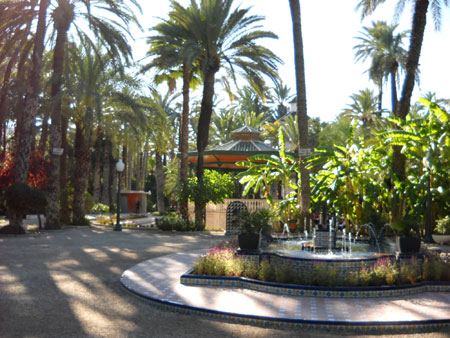
Places of interest Elche
If you arrive in Elche by train or bus, you get off north of the city centre. The many palm trees and parks are immediately noticeable. It is best to walk through the official city park of Elche (Parque municipal, see picture above) in direction to the old town.
In the beautiful park, thousands of palm trees stand close to each other. Between the palm trees there are playgrounds, fountains and even a small church. At the southern end of the city park is the tourist information of Elche (very nice and helpful staff).
Our tip: Ride the catamaran off the coast of Alicante. Short cruise (duration 2 hours) with drinks etc. for only 32 euros. Great experience, we liked it very much: >>> More information and booking
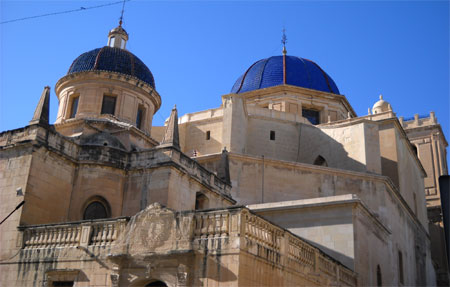
Leaving the city park of Elche in southern direction you reach the old town. The largest and most striking building here is the baroque basilica. Like many churches on the Costa Blanca, the Basilica Santa Maria in Elx (also called Ascension Church) has the typical domes with the blue roofs. The ascent of the church tower is highly recommended. From the top you have a very good view over the city of Elche with its many palm gardens and green areas.
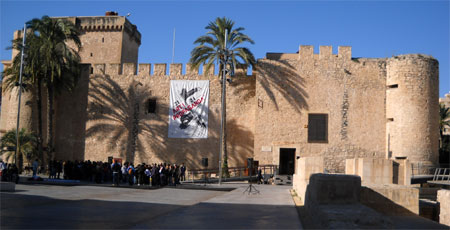
The other important building in Elche is the Palacio de Altamira, just 100 metres from the church described above. The castle was built in the 15th century. Today it houses the modern Archaeological Museum of Elche (admission 3€, closed Monday), which is the most important museum of the city. However, there are some other interesting museums in Elche:
Museo de la Festa Elche: Here you can see old clothes worn at festivals (admission 3€, near the basilica).
Museo de Palmerar Elche: The palm and palm garden museum. Not far from the Huerto de Cura described below (entrance fee 1€).
Bany Arab: The old Arab baths of Elche can also be visited. Centrally located and certainly worth the entrance fee of just one euro.
Museu d Art Contemperorani Elche: Museum of Contemporary Art, admission 2 Euro.
Opening hours museums in Elche: Most of the museums are closed on Monday and have the long siesta typical for Spain. They are usually open in the morning at 1 pm and for a few hours from around 5 pm.
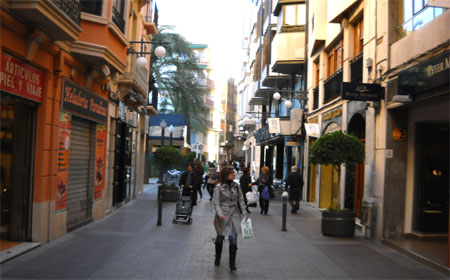
In the city centre of Elx (part of the old town) there are some pedestrian zones with many smaller shops. Here it is still rather Spanish, the influence of the tourism is here clearly less to feel than in the cities at the near coast Costa Blanca. Here, one also finds the city hall (Ayuntamiento) of Elx that is worth seeing.
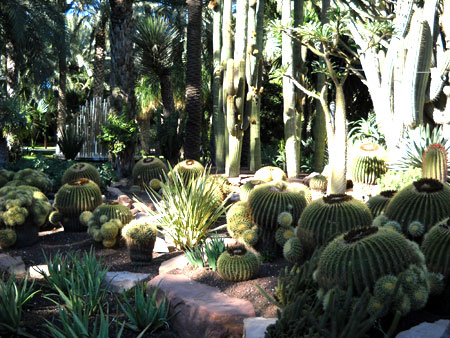
For most tourists, the highlight of a visit to Elche is a visit to the palm gardens. By far the most famous is the Huerto del Cura Botanical Gardens, just one kilometre from the centre. Especially the meter high cacti inspire many tourists from northern countries. The entrance fee to the small botanical garden Huerto del Cura is unfortunately a little too high and amounts to 5€ for adults. Inside there is a shop where you can buy packages with seeds of the famous date palms of Elche for 1,80 Euro. Around the Huerto del Cura there are many other parks and gardens worth seeing (the so-called Palmeral of Elche) with palm trees and other plants. These do not cost an entrance fee, but are also worth seeing. One should definitely plan some hours for the many gardens. The Palmeral in Elx with its all together several 100.000 palms is a UNESCO world cultural heritage since 2006.
Arrival Elche
The railway station and the bus station are both about 1 km north of the city centre and 200 metres apart. The train station has recently been modernised. Caution: There are two stations in Elche. From Alicante, get off at the first station (or from Murcia, the second station) “Elche Parq”. Local trains on the Alicante-Elche-Murcia line run at least every hour during the day, and significantly more often at peak times. A return ticket from Alicante costs just 3.30 euros. From the bus station there are frequent buses to Alicante, Torrevieja, Santa Pola, Murcia and other cities. Buses are faster in this region of Spain and run more frequently than trains. Likewise, the trip with the bus is not expensive: the fare for a one-way trip Alicante-Elche is just 1.90 euros. With the car one arrives just as fast to Elche. The motorway 7 along the Mediterranean coast goes directly past Elche, one simply takes the exit Elche (Elx).
Elche Top 10 Sights
Elche is a beautiful town in Alicante, Spain. Here are the top 10 things to do in Elche.
Palmeral of elk :
This is a huge palm grove with over 200,000 palm trees and is a UNESCO World Heritage Site. It is a unique cultural and ecological landscape and a must-see attraction.
Cathedral of Saint Mary :
This is a beautiful gothic church in the center of town. It was built between the 15th and 18th centuries and is famous for its impressive blue dome.
Archaeological Museum of Elche :
The museum houses a collection of archaeological artefacts from the Iberian, Roman and Arabic periods. An ideal place to explore the history of the region.
Huerto del Cura:
A beautiful garden in the center of the city. Famous for its palm tree collection, including the famous seven-branched imperial palm.
Altamira Castle :
The castle was built in the 13th century and served as a fortress and prison. Today it is a cultural center and offers a magnificent view of the city.
Calahorra Tower :
Built in the 15th century, the tower is one of the few remaining Islamic buildings in the city. It is located in the old town and offers a wonderful view of the surroundings.
Palm Grove Museum in Elche :
This museum is dedicated to the history and cultivation of palm trees in the region. It provides an excellent overview of the cultural and ecological importance of palm trees.
Plaza Santa Isabella:
This is a nice square in the center of town. Surrounded by historical buildings, it is the ideal place to relax and soak up the atmosphere.
Elche Municipal Park :
This is a large park on the outskirts of town. It is an ideal place for a walk or a picnic and offers beautiful views of the surrounding countryside.
Archaeological site L’Alcudia:
Just outside of town, the site houses a collection of Iberian and Roman ruins. An ideal place to learn more about the history of the region and explore the ancient ruins.
Palmeral of Elche
The Palmeral de Elche is a huge palm grove in the city of Elche, Alicante, Spain. It is one of the largest and best preserved palm groves in Europe and was declared a UNESCO World Heritage Site in 2000.
Palmeral covers an area of more than 3,000 hectares and includes over 200,000 palm trees. They were probably planted during the Moorish occupation of Spain in the 10th century and have been carefully cultivated and preserved over the centuries.
The palm trees are an eclectic mix of species, including the famous date palm, which gives rise to the famous Elche date palm. Palmeral also includes a network of irrigation canals and aqueducts that were built during the Arab occupation of the area and are still used today to irrigate the palm trees.
In addition to its cultural and historical importance, Palmeral is also an important ecological site, providing habitat for a wide variety of birds and other wildlife.
Visitors to Elche can explore the Palmeral on foot or by bike, following a network of paths and trails that wind through the palm trees. The Palmeral also features several gardens, parks and other attractions. These include the Weruto del Cura, a beautiful garden with a collection of rare and exotic palm trees, and the Palm Museum of Elche, which offers an interesting insight into the history and cultivation of palm trees.
Huerto de Cura Elche
The Huerto del Cura, also known as the Garden of the Priests, is a beautiful garden in the city of Elche, Alicante, Spain. It is located in the Elche palm grove, a vast palm grove declared a UNESCO World Heritage Site.
The garden originally belonged to a priest named José Castaño Sánchez, who built the garden in the late 19th century. Over time, the gardens became a popular attraction, and in 1943 it was purchased by the city of Elche.
The garden covers an area of approximately 12,000 square meters and is famous for its palm collection, including the famous seven-armed imperial palm, which is considered one of the most beautiful and unique palm trees in the world. In addition to the palm trees, the garden is also home to a variety of plants such as cacti, succulents and flowering shrubs. The gardens are divided into different areas, each with its own unique features and attractions, including ponds, small waterfalls, walking paths and shaded paths.
One of the highlights of the garden is the pergola, a covered walkway lined with vines and flowers. A pergola leads to a small chapel in the center of the garden dedicated to the Assumption of the Virgin Mary.
An oasis of peace and tranquility in the city of Elche, Wert del Cura is a popular destination for travelers looking to enjoy the beauty of nature away from the urban hustle and bustle.
Elche old town
Elche Old Town is a charming and historic neighborhood in the heart of the city of Alicante in Spain. It consists of narrow streets, picturesque squares and historic buildings, many of which date back to the Middle Ages.
One of the main attractions of the old town is the beautiful Gothic church of Santa Maria, built between the 15th and 18th centuries. century was built. This church is famous for its impressive blue dome and beautiful stained glass windows.
Another highlight of the old town is the Calahorra Tower, a 15th-century medieval tower and one of the few surviving examples of Islamic architecture in the city. The tower stands at the entrance to the old town and offers an excellent view of the surrounding area.
The old town has many beautiful squares, including Piazza Glorieta and Piazza Fruita, both popular meeting places for locals and tourists. Surrounded by cafes and restaurants, the square is the perfect place to relax and soak up the atmosphere.
Visitors to the old town can also explore the narrow streets and alleys that crisscross the neighborhood. Many of them are lined with traditional houses and shops. The streets, full of personality and charm, are the perfect place to immerse yourself in the city’s history and culture.
Our tips: Prepare good websites for holidays in Spain for the 2025 season |
Are you looking for cheap hotels in Spain >>> Click heree
|
Best Website for Bus Excursions, Tickets ,,, : >>> Click Here |
Cheap rental cars in Spain: >>> Click here |
